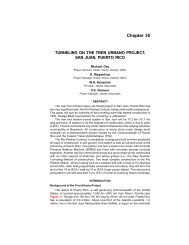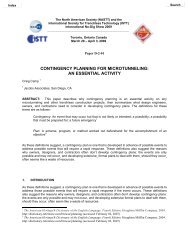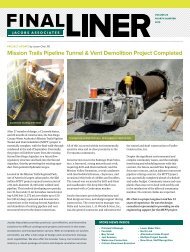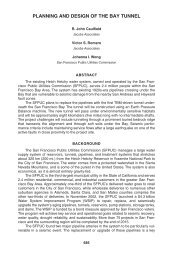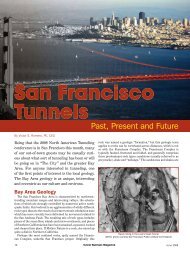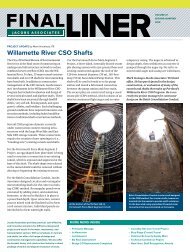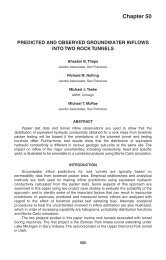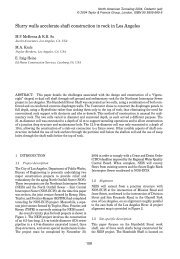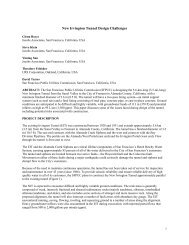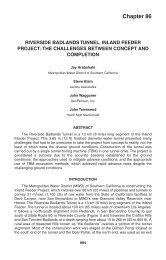First Quarter 2013 - Jacobs Associates
First Quarter 2013 - Jacobs Associates
First Quarter 2013 - Jacobs Associates
Create successful ePaper yourself
Turn your PDF publications into a flip-book with our unique Google optimized e-Paper software.
VolUME 31<br />
first QUARTER<br />
<strong>2013</strong><br />
Project update by Bhaskar Thapa, PhD, PE<br />
Tunneling Completed on Caldecott<br />
The Caldecott Improvement Project achieved<br />
a significant construction milestone with the<br />
completion of tunnel excavation in September<br />
2012 after almost two years of tunneling. The final<br />
lining installation, involving 69 lifts starting<br />
from the west portal, was completed in October<br />
2012. Remaining work items include roadway<br />
paving, completion of the tunnel structure at the<br />
east portal, and the installation, configuration,<br />
and integration of electrical, drainage, and ventilation<br />
systems. The completed tunnel is scheduled<br />
to open to traffic in late <strong>2013</strong>.<br />
<strong>Jacobs</strong> <strong>Associates</strong> is providing design support<br />
during construction. During the design phase<br />
as part of the Parsons team, we led the technical<br />
design for the tunnel structure and also<br />
coordinated the technical design for the tunnel<br />
systems and fire life safety systems. Our<br />
detailed design work included geomechanical<br />
characterization; design of initial tunnel<br />
support, final lining, and portal excavation<br />
support; seismic analysis; and cost estimating.<br />
Tutor Saliba Corporation and FoxFire Constructors<br />
are the construction contractors.<br />
Installation of waterproofing membrane.<br />
The Caldecott Improvement Project is a<br />
partnership of the Federal Highway Administration,<br />
the California Department of Transportation,<br />
the Metropolitan Transportation<br />
Commission, the Contra Costa Transportation<br />
Authority, and the Alameda County Transportation<br />
Commission.<br />
Bhaskar is a lead associate in the San Francisco<br />
office. He has been directly involved in the design<br />
of the Fourth Bore and is the NATM design<br />
representative on the Caldecott Construction<br />
Management Team.<br />
Project win<br />
Australian Win: Narrows Crossing<br />
Overview of Curtis Island site.<br />
<strong>Jacobs</strong> <strong>Associates</strong> is providing tunnel design to<br />
Thiess Tunnelling on the Narrows Marine Crossing<br />
Project. This 4.4-kilometer-long (2.7 mi),<br />
3.4-meter-inside-diameter (11 ft) tunnel will<br />
be constructed under a body of water known as<br />
“The Narrows.” It will connect the Australian<br />
mainland near Gladstone to Curtis Island, where<br />
the Santos Gladstone liquid natural gas plant is<br />
located. The tunnel will house the Santos GLNG<br />
gas transmission pipeline.<br />
Thiess Tunnelling was<br />
awarded a $134 million AUD<br />
contract by Saipem Australia,<br />
the national arm of worldwide<br />
pipeline specialist Saipem, to<br />
construct the tunnel for the<br />
Santos GLNG project in Gladstone,<br />
Queensland. Thiess<br />
purchased one of the earth pressure balance tunnel<br />
boring machines used to construct the Northern<br />
Sewerage Project<br />
(NSP) in Melbourne,<br />
which was completed<br />
last year, and plans to<br />
use the refurbished<br />
machine to construct<br />
the Narrows Crossing.<br />
Mobilization to<br />
the site began in September 2012, and tunneling<br />
activities are expected to begin early in <strong>2013</strong>.<br />
<strong>Jacobs</strong> <strong>Associates</strong> provides practical, cost-effective, and innovative<br />
solutions for difficult underground projects and excels in the water,<br />
wastewater, and transportation sectors. With an emphasis on tunnels<br />
and shafts, we offer a full range of design and construction management<br />
capabilities. We also offer the broader heavy civil construction<br />
industry a robust package of claims and dispute resolution services.<br />
more news inside<br />
• Principal’s Message<br />
• Drill and Blast<br />
• A Proactive CM Approach<br />
• James Wilton Award<br />
• Chase Challenge<br />
• Northgate Link Extension<br />
• Triple Hydropower Win<br />
• Muck Bucket<br />
• Oahu’s Sewer Tunnel Project<br />
• Passive Icing System<br />
• Norbert Tracy Scholarship<br />
• Brisbane Airport Tunnel Opens<br />
• Midwest Expansion<br />
• Larger Linings for Larger Tunnels
Principal’s message by Isabelle Lamb, LG<br />
Secrets to a Successful Owner/Designer Relationship<br />
2<br />
While <strong>Jacobs</strong> <strong>Associates</strong> is known for technical<br />
solutions, it may be our working relationships<br />
with our project owners and teaming partners<br />
that make the biggest difference in that success.<br />
The most productive working relationships are<br />
based on trust, and for public agencies with large<br />
projects, it’s how they relate to their design consultant<br />
that is the key to the overall success of the<br />
project design. This proves especially true when<br />
project funding is limited, necessitating the most<br />
cost-effective design solutions. So how do trustbased<br />
working relationships develop between<br />
owners and designers when the budget is the<br />
controlling factor The <strong>Jacobs</strong> <strong>Associates</strong> answer<br />
is: collaboration, consistency, communication,<br />
and effective subconsultant management.<br />
We have found that interactive, collaborative<br />
work environments, where designer and<br />
owner cooperate, yield the best solutions in the<br />
shortest time. Listening and being responsive<br />
allow us to address project needs with the right<br />
expertise and level of effort.<br />
The secret to providing the right design solution<br />
is an organic, mutually coherent understanding<br />
of these overall project needs. For<br />
larger efforts, this is best accomplished by an<br />
integrated work environment such as can be<br />
offered by collocation, where the designers are<br />
available to the owner, and vice versa, for effective<br />
communication, decision making, and<br />
alternatives evaluation.<br />
Once trust is established, the challenge becomes<br />
maintaining consistency in the design<br />
and across disciplines. For example, multifaceted<br />
projects, such as light rail involving both<br />
tunnels and stations, engage many designers<br />
from numerous and diverse disciplines and<br />
companies. In these complex work environments,<br />
it is even more critical to maintain<br />
integrated consistency project wide through<br />
effective team management.<br />
To enhance our project and team management<br />
expertise, <strong>Jacobs</strong> <strong>Associates</strong> conducts regular<br />
in-house project management training. The<br />
graduates from these courses are well-versed<br />
in topics ranging from planning to risk management<br />
and working with and managing<br />
different personalities and disciplines. The<br />
program teaches the fundamentals critical to<br />
success of our clients’ complex infrastructure<br />
projects. It’s these <strong>Jacobs</strong> <strong>Associates</strong> people<br />
who are making the difference in the way we<br />
do business—at all levels of management.<br />
To further assist in fully<br />
understanding the complexities<br />
of such projects,<br />
<strong>Jacobs</strong> <strong>Associates</strong><br />
has introduced virtual<br />
design and construction<br />
(VDC) tools, which improve<br />
visualization and<br />
provide a platform for<br />
integration and coordination<br />
between engineering<br />
disciplines. The<br />
Based out of Seattle,<br />
Isabelle is project<br />
manager for the<br />
Northgate Link Extension<br />
Light Rail project<br />
and project manager<br />
for the University Link<br />
Light Rail project.<br />
models generated prevent errors by identifying<br />
conflicts during design, when changes are easiest<br />
and most cost effective to make.<br />
While technology aids in coordination, the<br />
prime design consultant provides direction to<br />
the overall design team, and maintains the focus<br />
and energy essential to complete the design. The<br />
owner’s investment in the project is just beginning<br />
with the design phase, and our role as the<br />
prime design consultant is to maintain the momentum—keeping<br />
the process moving efficiently<br />
and effectively at all levels—to present the best<br />
solutions on schedule and on budget.<br />
just answers by Dwayne Easterling<br />
Drill and Blast<br />
Blasting. People have heard that this will be<br />
taking place in their neighborhood during the<br />
construction of a new tunnel. How concerned<br />
should they be Will it be like the special effects<br />
for a Sylvester Stallone movie<br />
Blasters have been in business excavating rock<br />
for generations. And with all of that experience,<br />
engineers have been able to set industry<br />
standards that protect neighboring property<br />
from both vibration and noise.<br />
Here is a quick thumbnail of how the contractor<br />
controls the blast. For each job, a blast plan<br />
is created by an engineer. The plan is based on<br />
the type of rock being blasted and the distance<br />
to any structures or utilities. Two-inch-diameter<br />
holes (50 mm) are drilled into the rock,<br />
6 to 8 feet deep (1.8–2.7 m), hence the term<br />
“drill and blast.” The holes are in a concentric<br />
circular pattern. Each hole is then packed with<br />
a prescribed amount of powder explosive.<br />
Now, here’s the trick. The blaster cannot set off<br />
all the powder at the same time. In the center<br />
of the face, a 6-inch (150 mm) hole is drilled<br />
but not filled with powder. This is the “burn”<br />
hole. A time delay is built into each hole via<br />
the blasting cap. These millisecond delays are<br />
wired together to make only one or a few holes<br />
go off at the same time.<br />
Rock wants to move just like<br />
water. Water finds the easiest<br />
path to flow, and so<br />
does rock. The blaster<br />
provides the “easiest<br />
path” for the rock<br />
through the burn<br />
hole. Contrary to<br />
what you might<br />
think, blasting rock<br />
is not the same as<br />
smashing it. With<br />
each blast, the rock<br />
is wedged apart<br />
with hot expanding<br />
gases. Taking the<br />
easiest path, the<br />
broken pieces move<br />
Sequence of blast, from light to dark, center to outside.<br />
towards the cavity produced by the burn hole.<br />
Each concentric circle of loaded holes then<br />
follows suit. The perimeter is the final circle<br />
that is blasted. This area has smaller drill holes<br />
packed with smaller loads of powder. Usually<br />
these trim holes have just enough powder to<br />
break the rock facing the burn hole. That is how<br />
the blaster controls the perimeter and<br />
shape of the excavated area.<br />
Don’t worry. Sylvester Stallone<br />
types will not be<br />
controlling the blasts.<br />
Unless of course, they<br />
take all the classes and<br />
tests required and then<br />
obtain a Blaster-in-<br />
Charge License.<br />
Dwayne is the chief<br />
inspector for <strong>Jacobs</strong><br />
<strong>Associates</strong>’ deep rock<br />
South Cobb Tunnel,<br />
located in Austell,<br />
Georgia.
3<br />
just answers by Shimi Tzobery, PE<br />
A Proactive CM Approach<br />
<strong>Jacobs</strong> <strong>Associates</strong> continues to take a construction manager role<br />
on large high-profile tunneling projects, including the Alaska Way<br />
Viaduct Project in Seattle and the San Francisco Central Subway<br />
Project. This is a good opportunity, therefore, to reexamine the<br />
importance of a proactive construction management (CM) approach<br />
to challenging projects.<br />
The success of a construction project is typically judged by whether<br />
it meets safety, cost, and schedule objectives. As recognized, cooperative<br />
relationships among the construction parties are essential<br />
in order for these project goals to be achieved and for a project to<br />
be considered successful. In the role of liaison, the CM and its team<br />
should encourage open communication, fairness, and trust among<br />
the owner, designer, contractor, and other project shareholders.<br />
Ideally, the CM assists the contractor in its efforts to achieve the<br />
project requirements, while also administrating the contract and<br />
its specifications. By proactively inspiring the project teams to work<br />
together toward the common project targets, the CM helps the parties<br />
to bridge their differences, resulting in a high level of performance,<br />
rapid troubleshooting, and effective conflict resolution.<br />
On tunneling projects, however, the CM is more than a liaison since<br />
uncertainty and risk are predominant on these projects. On such<br />
complicated, high-cost projects the CM team is routinely required<br />
to provide work directions (ground support, water control, ground<br />
treatments, etc.), as determined by the actual encountered ground<br />
conditions. This contractually assigned task may result in conflicts<br />
and disputes between the owner and contractor. Therefore, the CM<br />
should become intimately involved in the project partnering process<br />
so as to diffuse potential frictions between the parties.<br />
The following principles are suggested for tunnel construction<br />
managers in their proactive partnering approach:<br />
• Partnering is not a slogan. Engage in the partnering process<br />
every day.<br />
• Make teamwork and open communication a way of life throughout<br />
construction.<br />
• Never use the contract to enforce, unless engineering (and common<br />
sense) has failed to convince.<br />
• “Bring the contractor to the table” to jointly address key challenges.<br />
• Develop a Conflict Resolution Ladder while encouraging the team<br />
members to resolve issues at the lowest level.<br />
• Earn the trust of the owner, designer, and contractor through your<br />
ability to fairly negotiate a middle ground.<br />
• Educate the owner on the benefits of risk sharing.<br />
Tunneling projects are challenging, and the multifaceted role of the<br />
CM is critical to success. A well-selected CM will find the golden path<br />
to proactively assist the contractor without compromising any of the<br />
contract requirements or final product quality. It may not ultimately<br />
eliminate disputes, but such methodology can establish a solid and<br />
trusted ground for addressing them rapidly and fairly, resulting in<br />
the satisfaction of all involved parties and shareholders.<br />
Shimi is an associate in the Pasadena office and has nearly 20 years<br />
of experience in the design, coordination, and management of complex<br />
underground construction projects.<br />
Sam Swartz Receives<br />
James Wilton Award<br />
The principals at <strong>Jacobs</strong> <strong>Associates</strong> are pleased<br />
to announce that Sam Swartz, an associate in the<br />
Seattle office, is the 2012 recipient of the James<br />
Wilton Award. This is an employee award that<br />
honors the memory of James Wilton, former principal<br />
and president of <strong>Jacobs</strong> <strong>Associates</strong>.<br />
This award recognizes the accomplishments and contributions<br />
made by <strong>Jacobs</strong> <strong>Associates</strong> employees. It provides an opportunity<br />
to acknowledge their innovations, implemented into either a <strong>Jacobs</strong><br />
<strong>Associates</strong> project or our business operations and demonstrating<br />
an individual’s commitment to quality and excellence at the firm. A<br />
person receiving this award shares the<br />
traits that made Jim an “engineer’s engineer”—innovative,<br />
hardworking, practical,<br />
and meticulous.<br />
<strong>Jacobs</strong> <strong>Associates</strong> principals presented<br />
Sam with the James Wilton Award at the<br />
2012 management meeting in Lafayette,<br />
California, in November. Sam has almost 15 years of engineering<br />
experience on major tunnel design projects. He holds an MS in<br />
Civil Engineering from the University of California, Berkeley, and a<br />
BS in Civil Engineering from the University of Michigan. Sam also is a<br />
registered professional engineer in California and Washington. He is<br />
currently providing design support services during construction for<br />
Sound Transit’s University Link Light Rail project as well as acting as<br />
senior reviewer on Sound Transit’s final design of the Northgate Link<br />
Extension, both located in Seattle, Washington.<br />
Employees Take the Challenge!<br />
On Wednesday, September 13, 2012, the San Francisco and Walnut<br />
Creek offices participated in the 2012 San Francisco JPMorgan<br />
Chase Corporate Challenge. This event was a 3.5-mile (5.6 km) race<br />
at AT&T Park’s McCovey Cove. It was a gorgeous night for running,<br />
one of the warmest in recent years, and there was a sold-out crowd<br />
of 10,000 participants from 367 companies. This is the largest turnout<br />
in the San Francisco Corporate Challenge’s 28-year history.<br />
Principal Mike McRae led the team with the fastest time of 22.42 minutes.<br />
A record number of 34 <strong>Jacobs</strong> <strong>Associates</strong> employees took on<br />
the challenge.<br />
Part of the proceeds of the race was donated to Larkin Street Youth<br />
Services, an internationally recognized leader providing innovative,<br />
effective housing, medical, social, and educational services to at-risk,<br />
homeless, and runaway youth.
Project update by Steve Dekleva, PE<br />
Northgate Link Extension N112 Gets Underway<br />
4<br />
The Northgate Link Extension N112 contract<br />
broke ground in August 2012. N112 is the<br />
first of ten contracts to be awarded by Sound<br />
Transit for the construction of the Northgate<br />
Link Extension Light Rail Project, which will<br />
connect the University Link Light Rail segment<br />
to the Northgate business/retail center in<br />
Seattle, Washington. The N112 contract was<br />
awarded to Titan Earthwork and includes demolition,<br />
environmental remediation, and site<br />
preparation for the U District and Roosevelt<br />
Station sites. Upon the completion of the N112<br />
The groundbreaking ceremony.<br />
effort, the prepared sites will be taken over<br />
by the N125 contract, which is for the station<br />
excavation and tunneling operations, and then<br />
subsequently by the N140 and N150 Station<br />
build-out and finishes contracts.<br />
At the U District Station, several structures are<br />
being demolished, including a two-story bank<br />
building, an underground parking structure<br />
adjacent to the bank, a classroom building, and a<br />
residential structure and garage. Environmental<br />
conditions and hazardous building materials<br />
surveys were completed for<br />
each property, and abatement<br />
work based on the findings<br />
will be carried out before or in<br />
conjunction with demolition<br />
of the structures. The project<br />
budget covers the possibility of<br />
encountering unknown contamination<br />
throughout execution<br />
of the work. The concrete basement<br />
walls of the underground<br />
parking structure, classroom<br />
building, and residence will be<br />
left in place and the basements<br />
filled with a controlled density<br />
fill (CDF) backfill. The backfill<br />
will stabilize the basement walls<br />
and allow for removal of the structure above.<br />
The basement walls can then be removed, either<br />
during the N125 contract or after the stations<br />
are completed if needed. The classroom building<br />
demolition will be challenging as the north exterior<br />
wall is built tight against a historic theatre.<br />
Removal procedures will be closely monitored<br />
throughout demolition.<br />
A similar approach is being taken at the Roosevelt<br />
Station site. Buildings being demolished<br />
include a grocery store, two commercial buildings,<br />
and two small residential structures. To<br />
reduce demolition debris totals, four townhouse<br />
structures were permanently moved to a site<br />
three blocks away. The grocery store has a basement<br />
that will be filled in with CDF backfill. The<br />
aboveground portion of the basement wall will<br />
be supported by soil nails to allow it to remain<br />
after the building is demolished.<br />
After demolition, site restoration will occur<br />
at both sites, including construction of drainage<br />
structures, grading, surface treatments,<br />
and fencing.<br />
Steve is a project engineer in <strong>Jacobs</strong> <strong>Associates</strong>’<br />
Seattle office and the project manager for the<br />
Northgate Link Extension N112 contract.<br />
Triple Hydropower Win!<br />
<strong>Jacobs</strong> <strong>Associates</strong> continues to expand its hydropower and dams portfolio<br />
with three strategic wins: the Allison Lake Hydropower project in<br />
Valdez, Alaska; the Lower Baker Dam Flood Wall Project in Concrete,<br />
Washington; and the Tri-Dam Radial Gate Inspection in Pine Crest, California.<br />
Each of these is an example of leveraging our expertise toward<br />
a focused expansion in offerings that go beyond tunnels.<br />
Allison Lake Hydroelectric Project<br />
Located east of Anchorage in the southeast part of Alaska, Copper Valley<br />
Electric Association’s Allison Lake Hydroelectric project includes construction<br />
of a new 5-megawatt powerhouse<br />
and a 7,500-foot-long<br />
(2,290 m), 42-inch-diameter<br />
(1,065 mm) steel penstock and<br />
diversion intake structure. <strong>Jacobs</strong><br />
<strong>Associates</strong>, as a subconsultant to<br />
McMillen LLC, will be providing<br />
geological and geotechnical engineering for penstock alignment and<br />
powerhouse siting evaluation; and design of the penstock, a diversion<br />
intake structure, and powerhouse excavation and foundation. We also<br />
will provide engineering services during construction of the project.<br />
Staff Recognition<br />
At the annual Colorado<br />
School of Mines Tunneling<br />
Short Course in September,<br />
Glenn Boyce, PhD, PE, taught<br />
“Shaft Design and Construction,”<br />
while Michael McRae,<br />
DEng, PE, GE, taught “NATM<br />
Design and Construction.”<br />
The Tunneling Short Course is<br />
a three-day, intensive course<br />
presented by a panel of international<br />
experts.<br />
Mark Havekost, PE, gave a<br />
talk titled “Design and Construction<br />
Methodologies for<br />
Challenging Geotechnical<br />
Conditions on the Lower Baker<br />
Unit 4 Powerhouse Project” at<br />
the Vancouver Tunnelling Association<br />
of Canada (TAC) Conference<br />
on September 11, 2012. He<br />
also gave a presentation titled<br />
“Shaft Design and Construction<br />
Methodologies” at a Tunneling<br />
Technology and Emerging<br />
Trends and Technology Symposium<br />
for the City of Portland,<br />
Oregon on June 21, 2012.<br />
In October, Shawn Paroline<br />
moderated a discussion panel at<br />
the Construction Management<br />
Association of America (CMAA)<br />
Boyce McRae Havekost Paroline Pawlik<br />
National Conference, held in<br />
Chicago, Illinois. The discussion<br />
panel presented a white paper<br />
titled “Survival Guide for Managing<br />
Public Works Construction<br />
under Institutional Constraints.”<br />
Isabelle Pawlik, PE, Sarah Wilson,<br />
PE, and Julie Labonte from the San<br />
Francisco Public Utilities Commission<br />
(SFPUC) gave a presentation<br />
titled “Water Supply Reliability:<br />
Critical Tunnel Infrastructures in<br />
San Francisco” in October at the<br />
American Society of Civil Engineers<br />
(ASCE) 142nd Annual Civil<br />
Engineering Conference in Montreal,<br />
Quebec. The presentation<br />
featured three SFPUC projects—<br />
the Bay Tunnel, the New Irvington<br />
Tunnel, and the New Crystal<br />
Springs Bypass Tunnel.<br />
Jamie Schick, CEG, LEG, LHG,<br />
gave a presentation titled “Using<br />
HDD Technology to Successfully<br />
Wilson Schick<br />
Navigate the Urban Environment”<br />
to a Municipal Forum on<br />
Trenchless Technology for water<br />
and sewer municipalities in the<br />
greater Portland area. The talk<br />
highlighted <strong>Jacobs</strong> <strong>Associates</strong>’<br />
successful completion of five horizontal<br />
directional drilling (HDD)<br />
projects for the Tualatin Valley<br />
Water District. The forum was<br />
held in October and organized<br />
by the Louisiana Tech Trenchless<br />
Technology Center.
5 6 7<br />
Project update by Tom Pennington, PE<br />
Oahu’s Sewer Tunnel Project<br />
Like many US cities, the City and County of<br />
Honolulu is embarking on an ambitious plan to<br />
increase the reliability of its wastewater collection,<br />
treatment, and disposal systems. Planning<br />
and design for improvements are underway for<br />
facilities conveying wastewater flows by gravity<br />
on the windward side of Oahu, from the existing<br />
Kaneohe Wastewater Pretreatment Facility<br />
(KWPTF) to the Kailua Regional Wastewater<br />
Treatment Plant (KRWWTP). These improvements<br />
will replace the existing pump station<br />
and force main system. Improvements include<br />
an approximately 16,337-foot-long (4,980 m),<br />
120-inch-diameter (3,050 mm) wastewater storage<br />
and conveyance tunnel; a 36 million gallon<br />
per day (136 million liter) capacity pump station;<br />
two drop shafts; a deep intermediate access<br />
shaft; and near-surface pipelines and related<br />
improvements at the KWPTF and KRWWTP.<br />
<strong>Jacobs</strong> <strong>Associates</strong>, as a subconsultant to Wilson<br />
Okamoto Corporation, is providing design services<br />
for the tunnel and deep shafts.<br />
The tunnel will extend beneath the Oneawa<br />
Hills on the north side of Oahu. These hills are a<br />
topographic expression of a former caldera and<br />
shield volcano (Koo’lau Volcano) that helped<br />
form the island nearly 3 million years ago. Geologic<br />
conditions along the tunnel are expected to<br />
consist of basalt lava flows, breccias, and numerous<br />
dikes, all of which have undergone varying<br />
degrees of hydrothermal alteration due to their<br />
formation within the former volcano. Most of<br />
the tunnel will be mined in hard rock. At both<br />
ends of the tunnel, short sections of the alignment<br />
will encounter residual soils and weak<br />
Lagoonal and Alluvium deposits. Some of the<br />
soils have low strength and will require ground<br />
stabilization prior to tunnel excavation. Presently,<br />
over 20,000 cubic<br />
yards (15,300 3 m) of jet<br />
grouting are planned.<br />
A key design consideration<br />
is the use of glass<br />
fiber-reinforced thermosetting<br />
resin pipe<br />
(GFRP), or fiberglass<br />
pipe, as the tunnel final<br />
lining. The proposed<br />
tunnel diameter of 120<br />
inches (3,050 mm) is<br />
near the limit of manufacturing<br />
capabilities<br />
for GFRP. In addition,<br />
the pipe must be capable<br />
of withstanding<br />
internal corrosion and<br />
significant external hydrostatic pressure. Construction<br />
of the tunnel and shafts is expected to<br />
take 34 months and begin in late <strong>2013</strong>. Contractors<br />
must have a current Hawaii Contractor’s<br />
License when they submit their qualifications for<br />
the project.<br />
Tom is a senior project engineer in the San Francisco<br />
office and provides engineering design<br />
support on the Kaneohe/Kailua Project.<br />
Geotechnical investigations along tunnel alignment.<br />
Lower Baker Dam Flood Wall<br />
Again as a subconsultant to McMillen LLC,<br />
<strong>Jacobs</strong> <strong>Associates</strong> will be providing geotechnical<br />
and rock engineering on the design-build<br />
Lower Baker Dam Flood Wall project for Puget<br />
Sound Energy. The project, located in Concrete,<br />
Washington, consists of an 18-foot-high (5.5 m)<br />
dam raise to contain a probable maximum flood.<br />
Our services include site investigation, rock<br />
mapping, kinematic analyses, rock scour evaluations,<br />
FERC coordination, and field inspection<br />
during construction.<br />
Tri-Dam Radial Gate Inspection<br />
<strong>Jacobs</strong> <strong>Associates</strong> was selected to perform the Owner’s Dam Safety Evaluation<br />
of Tri-Dam Project’s 16 radial arm gates across three locations near<br />
Pine Crest, California. We will visually inspect the radial gates and hoisting<br />
systems at Donnells Dam (a double curvature concrete arch dam), Beardsley<br />
Dam (an embankment dam), and Tulloch Dam (a concrete gravity<br />
dam). Tulloch Dam is classified as a High Hazard dam, and Donnells and<br />
Beardsley dams are classified as Significant Hazard dams. Our team, consisting<br />
of <strong>Jacobs</strong> <strong>Associates</strong> and Black & Veatch engineers, will provide the<br />
civil/structural and mechanical engineering skills necessary to fully assess<br />
the operability and reliability of the dams’ spillway gates. The inspections<br />
and condition assessment are planned for completion prior to spring <strong>2013</strong>.<br />
New Hires<br />
Jose Aguilar was hired as a Staff<br />
Engineer in August, and works in<br />
the Vancouver office. Jose has<br />
experience as a geotechnical laboratory<br />
technician and as an assistant<br />
engineer on the construction<br />
of a subway station and tunnel in<br />
Spain. He holds a BA in Geological<br />
Engineering from the University of<br />
British Columbia.<br />
The Seattle office welcomed Katy<br />
Beaudreau, who started as an<br />
Administrative Assistant in August.<br />
Katy has more than eight years of<br />
administrative experience.<br />
Christopher Caruso joined the<br />
Boston office in November as a<br />
Senior Staff Engineer. His three<br />
years of experience include tunnel<br />
and trenchless design and rehabilitation<br />
techniques for steel and<br />
unreinforced concrete structures,<br />
unreinforced rock excavations,<br />
and utility pipelines. Christopher<br />
received his MS in Structural Engineering<br />
from the University of<br />
California at Berkeley and his BS<br />
in Engineering from Swarthmore<br />
College in Pennsylvania.<br />
Daniel Ebin joined the New<br />
York office as a Staff Engineer in<br />
August. His educational background<br />
is in both geotechnical<br />
and structural engineering, and he<br />
completed his Master’s research<br />
by modeling offshore wind turbine<br />
monopile foundations using Plaxis<br />
3D. He holds MS and BS degrees<br />
in Civil Engineering from Tufts<br />
University in Medford, MA.<br />
In January, the Cleveland office<br />
welcomed Charles Huse as<br />
a Staff Engineer. His experience<br />
includes geotechnical and<br />
environmental services. He has<br />
assessed residential structures for<br />
earthquake and mine subsidence<br />
damage, and conducted Phase I<br />
Environmental site investigations<br />
for commercial and industrial properties.<br />
Charles has a BS in Civil<br />
Engineering from Valparaiso University<br />
in Indiana.<br />
Vinnie Hung was hired in August<br />
as a Senior Staff Engineer and<br />
works in the San Francisco office.<br />
Vinnie has three years of experience<br />
in construction, geotechnical<br />
instrumentation engineering, and<br />
hydraulic groundwater modeling<br />
for a variety of transit tunnel<br />
projects. She holds an MEng in<br />
Civil Engineering from the Massachusetts<br />
Institute of Technology<br />
and a BS in Civil Engineering from<br />
Cooper Union in New York, NY.<br />
In November, the Portland office<br />
welcomed Lori Lyons-Lachman as<br />
a Project Consultant in the Claims<br />
Department. Lori has more than<br />
20 years of experience in construction<br />
claims consulting and<br />
paralegal work, specializing in<br />
litigation graphics and document<br />
review/analysis. She holds a BA in<br />
Architecture from the University<br />
of California at Berkeley.
Project update by Phaidra Campbell<br />
Passive Icing System on Allegheny and Moffat Tunnels<br />
4 5 6<br />
Tunnels take abuse. In railway systems, this<br />
abuse comes from a variety of sources, including<br />
the vibrations of passing heavy freight trains,<br />
seismic activity, exhaust exposure, and extreme<br />
weather conditions. Tunnels therefore require<br />
constant attention and innovative rehabilitation<br />
measures to prolong their lifespan, maintain<br />
safe passage, and counteract the forces<br />
of nature. In areas of heavy water infiltration<br />
and cold temperatures, water icing is an often<br />
dangerous and frequent occurrence. Two tunnel<br />
systems in two different parts of the country<br />
recently required installation of passive icing<br />
Installing steel sets and channel lagging for the<br />
passive icing shields in Moffat Tunnel in Colorado.<br />
Tri-Dam Project is a joint venture between<br />
the Oakdale Irrigation District and<br />
the South San Joaquin Irrigation District.<br />
Together they developed, operate, and<br />
maintain the Beardsley, Donnells, and<br />
Tulloch projects, including dams, tunnels,<br />
penstocks, powerhouses, communications<br />
systems, and general offices.<br />
These facilities are located on the Middle<br />
Fork of the Stanislaus River in Tuolumne<br />
County, California.<br />
systems to counteract cold weather: the Allegheny<br />
Tunnel in central Pennsylvania, which<br />
received a retrofit of an existing system; and the<br />
Moffat Tunnel in Colorado.<br />
The 3,600-foot-long (1,100 m) Allegheny Tunnel,<br />
originally constructed between 1851 and<br />
1854, was enlarged from single-track to a<br />
double track/double stack in the mid-1990s. As<br />
a part of this enlargement, passive icing shields<br />
were installed for approximately 335 linear feet<br />
(102 m). However, after 15 years, many of the<br />
panels are seriously deteriorated because of<br />
locomotive exhaust blasts and rusting of rock<br />
bolt hangers. This deterioration, along with<br />
extreme conditions in the winter of 2009/2010,<br />
proliferated the growth of large icicles, which<br />
required removal by Norfolk Southern Railway<br />
(NSR) crews every other day.<br />
To remedy these issues, NSR hired <strong>Jacobs</strong> <strong>Associates</strong><br />
to design a retrofit/replacement of<br />
the existing icing shields that would fit in the<br />
clearance envelope and be constructed in 2- to<br />
6-hour work windows. After a site visit, <strong>Jacobs</strong><br />
<strong>Associates</strong> determined a new passive icing system<br />
would be the best solution to control the<br />
icing issues. The new system consists of steel<br />
sets spaced evenly or centered into the existing<br />
Placing final shotcrete layer<br />
on the passive icing shields.<br />
concrete footings; between the steel sets is a<br />
layered arrangement of components. This arrangement,<br />
going from the field side to the track<br />
side, consists of a drainage mat and two layers of<br />
insulation planks. The track side of the steel sets<br />
and the insulation planks are covered with galvanized<br />
metal Stay-Form ® and a 2-inch (50 mm)<br />
layer of fiber-reinforced microsilica shotcrete.<br />
A passive icing system also was installed in<br />
Union Pacific Railroad’s Moffat Tunnel from<br />
October 2012 to December 2012. Moffat Tunnel<br />
is located on the Continental Divide in Winter<br />
Park, Colorado. Approximately 70 linear feet (21<br />
m) was installed midway through the tunnel in a<br />
severe icing zone. In addition to the icing shield<br />
materials, a waterproofing membrane (Masterseal)<br />
was used on the steel sets for an extra<br />
layer of protection from freezing water. Similar<br />
designs have been used in Washington State<br />
Parks’ Iron Horse Tunnels.<br />
By fully understanding the issues specific to the<br />
Allegheny and Moffat tunnels, <strong>Jacobs</strong> <strong>Associates</strong>’<br />
engineers tailored a proven rehabilitation<br />
method to reduce winter icing, decrease intervention<br />
of railroad crews, and allow safe passage<br />
of heavy freight trains.<br />
Phaidra is a project engineer in the San Francisco<br />
office and provided design and construction<br />
management services on the Allegheny Ice<br />
Shield Replacement Project and design services<br />
on the Moffat Tunnel Icing Project.<br />
transfers<br />
Babs Marquis recently joined<br />
<strong>Jacobs</strong> <strong>Associates</strong> as a Senior<br />
Project Consultant in the Boston<br />
Office. Babs will be involved on<br />
NBC Combined Sewer Abatement<br />
Program Phase II in Rhode Island<br />
and DC Water. Babs received his<br />
BS degree from Wentworth Institute<br />
of Technology in Boston and<br />
has more than 20 years of experience<br />
in the industry.<br />
The Seattle office hired JR Meksavanh<br />
as a Claims Technician<br />
in September. JR holds a BA in<br />
Geography from the University of<br />
Washington.<br />
The San Francisco office welcomed<br />
Staff Engineer Roozbeh Geraili<br />
Mikola in August. Roozbeh recently<br />
earned his PhD in geotechnical<br />
engineering from the University<br />
of California, Berkeley. His areas<br />
of expertise include earthquake<br />
engineering, rock mechanics and<br />
rock engineering, geotechnical<br />
engineering, numerical modeling,<br />
and ground support in mining and<br />
underground construction.<br />
In December, the San Francisco<br />
office welcomed Audie Reynolds<br />
as an Inspector on the Central Subway<br />
Project. Audie has 21 years<br />
of experience in the construction<br />
industry, including heavy rail construction,<br />
light rail construction,<br />
tunnel mining foundations, and<br />
water treatment facilities. Audie is a<br />
Certified Licensed Gas Tester and<br />
Certified Licensed Underground<br />
Safety Representative.<br />
Pamela “PJ” Roscoe, CPSM,<br />
joined the Boston office in<br />
December as a Marketing Manager.<br />
She has more than 10 years<br />
of AEC industry experience,<br />
which includes proposal development,<br />
graphic design, and<br />
market research. PJ holds a BA in<br />
Business Administration from Lesley<br />
University in Cambridge, MA.<br />
Katerina Sakarova, CEng, was<br />
hired in October by the Vancouver<br />
office as a project engineer.<br />
She has six years of experience<br />
in design and construction of tunnels,<br />
shafts, and underground<br />
structures, specializing in the<br />
design of sprayed concrete linings<br />
and cast-in-situ concrete<br />
linings in hard rock. She holds<br />
an MS in Building and Structural<br />
Engineering from Czech Technical<br />
University in Prague.<br />
Senior Associate Keith Abey,<br />
SE, Project Engineer Phaidra<br />
Campbell, and Senior Inspector<br />
Bill Hawk all transferred to the<br />
San Francisco office in September.<br />
Keith continues to support<br />
the Seattle Northgate Link Extension<br />
project, and also is working<br />
on expanding the firm’s structural<br />
engineering services in California.<br />
Phaidra continues to work on Seattle<br />
City Light’s Gorge 2nd Hydropower<br />
Tunnel project as well as on<br />
the Kaneohe/Kailua Sewer Tunnel<br />
project in Honolulu, HI and various<br />
railroad projects throughout
7<br />
Project update by Karl Assi, MIEAust, CPEng<br />
Brisbane Airport Tunnel Opens<br />
On July 25, 2012, Brisbane’s new Airport Link<br />
Tunnel opened to traffic. The ambitious project<br />
is known for many firsts. It is Australia’s longest<br />
road tunnel (at 6.7 kilometers, or almost 4.2 miles)<br />
and biggest privately funded road infrastructure<br />
project ($4.8 billion AUD). Airport Link runs under<br />
densely populated inner-city Brisbane and the<br />
northern suburbs. It connects the city’s central<br />
business district and recently completed northsouth<br />
bypass tunnel (the Clem7) to the East-West<br />
Arterial Road and to the Brisbane Airport.<br />
Construction started in November 2008, and<br />
completed on July 15, 2012. Two earth pressure<br />
balance tunnel boring machines (TBMs)<br />
were used to mine the 2.4-kilometer-long (1.5<br />
mi) twin bore section of the tunnel. The TBMs<br />
were custom-made for the project, and at 12.48<br />
meters (40.94 ft) in diameter, are the largest to<br />
The completed tunnel.<br />
have ever operated in Australia. The remainder<br />
of the tunnel was mined by roadheader<br />
and drill-and-blast methods. At the peak of<br />
construction, over 15 of the world’s largest<br />
roadheaders and the two TBMs were operating<br />
simultaneously. The project saw the installation<br />
of 125,000 tonnes (335 million pounds) of<br />
reinforced steel, and the application of 807,000<br />
cubic meters (28.5 million cubic feet) of concrete.<br />
During its peak, Airport Link employed<br />
4,500 people.<br />
The mined portion of Airport Link includes twin<br />
three-lane mainline tunnels; 5 one- to three-lane,<br />
on- and off-ramp tunnels; and a two-lane busway<br />
tunnel. The finished span of the mainline tunnels<br />
is approximately 15 meters (49 ft), and the spans<br />
of the caverns at the ramp tunnel intersections<br />
are up to 26 meters (85 feet).<br />
BrisConnections, a public-private partnership,<br />
contracted with Theiss – John Holland to construct<br />
the project. The Parsons Brinckerhoff<br />
Arup Joint Venture provided comprehensive<br />
engineering services. <strong>Jacobs</strong> <strong>Associates</strong> was<br />
engaged by the JV to provide design services,<br />
which consisted of input during development<br />
of the project-wide geologic report, final lining<br />
design for all the mined tunnels, and designing<br />
the initial support systems for sections of the<br />
ramp tunnels and caverns. We also provided<br />
design services during construction.<br />
Airport Link is part of an integrated transport<br />
solution that includes the Northern Busway and<br />
the Airport Roundabout Upgrade. Although a<br />
toll-road tunnel, for the first three months of operation,<br />
Airport Link was toll free to all motorists.<br />
Karl is a lead associate and manages <strong>Jacobs</strong><br />
<strong>Associates</strong>’ Melbourne office. He was technical<br />
lead for design of the final concrete linings for<br />
the Airport Link Project, and provided engineering<br />
support during construction.<br />
Norbert Tracy Scholarship<br />
Greg Rogoff, a graduate student in the<br />
GeoEngineering Program<br />
at the University of California,<br />
Berkeley, was recently<br />
awarded the Norbert A.<br />
Tracy Scholarship. This<br />
scholarship, funded entirely<br />
by <strong>Jacobs</strong> <strong>Associates</strong>, is the firm’s way of<br />
honoring the memory of our former partner,<br />
Norbert Tracy, and supporting UC Berkeley’s<br />
GeoEngineering graduate program,<br />
of which many at <strong>Jacobs</strong> <strong>Associates</strong> are<br />
alumni. Gregg worked at <strong>Jacobs</strong> <strong>Associates</strong><br />
as an intern after completing his undergraduate<br />
degree at UC Berkeley.<br />
papers presented<br />
the United States. Bill recently<br />
worked on Maryland’s Bi-County<br />
Water Tunnel project and is now<br />
serving as an inspector on the<br />
Central Subway Project in downtown<br />
San Francisco.<br />
Project Engineer Rusty Arend,<br />
PE, transferred from the Seattle<br />
office to the Walnut Creek office<br />
at the beginning of October. He is<br />
working on a variety of projects,<br />
with a primary focus on those<br />
utilizing trenchless technology.<br />
Senior Staff Engineer Stephanie<br />
Fekete transferred from the<br />
Ontario project office to the Vancouver<br />
office in September. In<br />
Vancouver, Stephanie is working<br />
on various projects for hydropower<br />
and mining industry clients.<br />
Associate John Murray, PE, and<br />
Project Engineer Bade Sozer, PE,<br />
both transferred from the Ontario<br />
project office back to the New<br />
York office in September. John<br />
is working on the Rondout-West<br />
Branch Bypass Tunnel project<br />
and continues to support the<br />
Ottawa Light Rail Transit project.<br />
Bade also is supporting the Rondout-West<br />
project.<br />
Senior Staff Engineer Heather<br />
Stewart, PE, transferred from the<br />
San Francisco office to the Seattle<br />
office in September. Heather is<br />
wrapping up work associated<br />
with her San Francisco projects<br />
as she takes on her new duties in<br />
Seattle.<br />
AMERICAN RAILWAY ENGINeer-<br />
ING AND MAINTENANCE-OF-<br />
WAY ASSOCIATION (AREMA)<br />
CONFERENCE (September 16–19,<br />
2012) Passive Icing Shields for<br />
Railroad Tunnel in Gallitzen, PA.<br />
Phaidra Campbell and Joseph<br />
Schrank (<strong>Jacobs</strong> <strong>Associates</strong>); Ruth<br />
Brown (Norfolk Southern Railway).<br />
TUNNELLING ASSOCIATION OF<br />
CANADA (TAC) CONFERENCE<br />
(October 17–20, 2012) Evaluation<br />
of Overstressing of Deep Hard<br />
Rock TBM Excavated Tunnels in<br />
BC. Dean Brox (<strong>Jacobs</strong> <strong>Associates</strong>).<br />
TUNNELLING ASSOCIATION<br />
OF CANADA (October 17–20,<br />
2012) Construction of the<br />
Sunnydale Auxiliary Sewer:<br />
Solving Unique Crossing<br />
Constraints using Multiple<br />
Excavation Methods. Renée<br />
Fippin and Heather Stewart<br />
(<strong>Jacobs</strong> <strong>Associates</strong>); Gregg<br />
Rehak (Super Excavators, Inc.);<br />
and Louis Douglas (San Francisco<br />
Department of Public Works).
8<br />
project win<br />
Putting Down Roots in the Midwest<br />
In September 2012, <strong>Jacobs</strong> <strong>Associates</strong> kicked<br />
off work on the City of Akron’s $220 million<br />
Ohio Canal Interceptor (OCI) Tunnel Project,<br />
our first big project win since opening a permanent<br />
office in the Midwest. The key feature<br />
of the project is a proposed 27-foot-insidediameter<br />
(8.2 m), 6,150-foot-long (or equivalent<br />
volume to provide approximately 25.6<br />
million gallons), combined sewer overflow<br />
(CSO) storage and conveyance tunnel in<br />
soil, rock, and mixed face ground conditions<br />
through downtown Akron, Ohio.<br />
The OCI Tunnel Project is part of a long-term<br />
CSO control plan that includes a number of<br />
sewer separation projects, storage tanks, treatment<br />
facility upgrades, and tunnels. The OCI<br />
Tunnel is expected to reduce CSOs at nine locations<br />
along the Ohio and Erie Canal and Little<br />
Cuyahoga River, improving water quality of<br />
the river and contributing to the overall health<br />
of the downstream Cuyahoga River and Lake<br />
Erie. The Cuyahoga River flows through the<br />
Cuyahoga Valley National Park.<br />
As a subconsultant to the prime designer, DLZ,<br />
<strong>Jacobs</strong> <strong>Associates</strong> is lead tunnel designer of<br />
the OCI Tunnel. As part of our scope of work,<br />
we are providing review of the preliminary<br />
engineering and design work completed by the<br />
Program Management Team led by AECOM.<br />
We also are participating in risk management<br />
Downtown Akron, future location of OCI Tunnel.<br />
meetings and a value engineering study, evaluating<br />
and presenting alternate design concepts<br />
for tunnels and shafts, and assisting with<br />
development of the geotechnical investigation<br />
program in preparation for final design of the<br />
OCI Tunnel. In addition, <strong>Jacobs</strong> <strong>Associates</strong> will<br />
provide engineering support services during<br />
construction, which, per the proposed consent<br />
decree, is scheduled to start in April 2014.<br />
just answers by Shannon Goff, PE<br />
Designing Larger Linings for Larger Tunnels<br />
Increasing demand for multiuse tunnels in<br />
order to optimize underground space and improvements<br />
in tunnel boring machine (TBM)<br />
technology have led to a worldwide increase<br />
in bored tunnel diameters. The list of successful<br />
projects with diameters greater than 14<br />
meters (46 ft) is growing. The largest TBM to<br />
date, with an outside diameter of 17.48 meters<br />
(57.35 ft), has been manufactured for the<br />
Alaska Way Viaduct Program. Consequently,<br />
this trend towards larger diameter tunnels is<br />
driving the need for the design of larger diameter<br />
segmental linings.<br />
In addition to the standard design considerations<br />
for all segmental linings such as grouting<br />
requirements, watertightness, durability,<br />
fire resistance, and installation tolerances,<br />
larger diameter linings present some new<br />
design challenges. There is an increased<br />
importance on development of practical geotechnical<br />
parameters for large-diameter tunnels.<br />
The structural capacity requirements of<br />
the ring are driven by the assumed ground<br />
loading with an increased dependency on the<br />
lateral earth pressure coefficient. Even minor<br />
deviations of this coefficient have a dramatic<br />
effect on the loads in the lining. Additionally,<br />
the stability of the ring depends on the<br />
bedding provided by the grout and ground<br />
behind the ring.<br />
We appreciate your feedback.<br />
finalliner@jacobssf.com<br />
The trade-off between flexibility and strength<br />
becomes more critical. This trade-off must be<br />
considered when selecting the number of segments<br />
per ring, the thickness of the ring, the<br />
type of reinforcement, and the type of joints.<br />
All of these compounds have significant constructability<br />
implications. A more flexible ring<br />
that uses more segments, a thinner section,<br />
lighter reinforcement, and uncoupled joints results<br />
in lower bending moment requirements<br />
but higher, potentially unacceptable, deformations.<br />
The deformations are smaller for a rigid<br />
ring; however, the bending moments can be<br />
incredibly high for large rings, and it can be<br />
difficult to design for them.<br />
The design basis of a segmental lining is an<br />
articulated ring, where the longitudinal joints<br />
provide the required flexibility. As ring flexibility<br />
becomes a more important design<br />
parameter, so too does the designer’s understanding<br />
of ring behavior. It is generally agreed<br />
that bending moment is transferred across the<br />
longitudinal joints because of the thrust forces<br />
in the ring, but there are various theories on<br />
the amount of moment transferred. Similarly,<br />
there are various theories on the behavior of the<br />
circumferential joints in terms of ring coupling<br />
effects. Ring coupling, due to friction between<br />
rings or shear connectors such as shear bicones<br />
or cam-and-pocket systems, can serve to stiffen<br />
Visit us at www.jacobssf.com<br />
or call us at 800.842.3794<br />
Large-diameter segmentally lined tunnel.<br />
a segmental lining. However, this effect is difficult<br />
to quantify. The major benefit from shear<br />
connectors is seen during ring build, when they<br />
act as centralizers and help restrict relative<br />
deformation between rings. However, construction<br />
tolerances and the shear connectors’ longterm<br />
behavior must be considered in order to<br />
avoid damage to segments.<br />
These are just some of the design challenges<br />
for large-diameter segmental linings. Recent<br />
advances in TBM technology are pushing the<br />
envelope, with tunnels larger than previously<br />
thought possible and under more critical loading<br />
conditions than ever before. Similar advancements<br />
in segmental lining design are required to<br />
continue this successful and exciting trend.<br />
Shannon is a project engineer in the Auckland<br />
office and is currently working on the Waterview<br />
Project.<br />
Executive Editor Victor Romero, PE, CPEng<br />
Managing Editor Rebecca Anicich, CPSM<br />
Contributing Editors Lauren Curley; LE McCutcheon,<br />
CPSM; Julie McCullough; Carl Williams<br />
Designer Seth McGinnis<br />
San Francisco, CA 415.434.1822<br />
Boston, MA 781.852.0450<br />
Cleveland, OH 216.292.9710<br />
New York, NY 212.376.1310<br />
Pasadena, CA 626.737.6520<br />
Portland, OR 503.227.1800<br />
San Diego, CA 619.565.2747<br />
Seattle, WA 206.588.8200<br />
Walnut Creek, CA 925.945.0677<br />
Washington, DC 571.357.1879<br />
Auckland, New Zealand +64 9 551 2325<br />
Docklands, VIC, AUS +61 3 8102 1800<br />
Vancouver, BC, Canada 604.336.8638<br />
© <strong>2013</strong> <strong>Jacobs</strong> <strong>Associates</strong>




